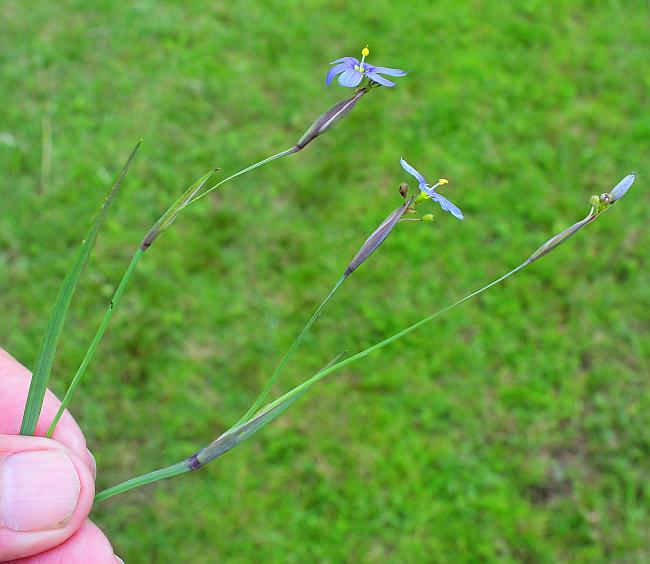Sisyrinchium atlanticum E.P. Bicknell
Eastern Blue-Eyed Grass

Native
CC = 9
CW = -3
MOC = 14
SRank = S2
© SRTurner
Sisyrinchium atlanticum E.P. BicknellEastern Blue-Eyed Grass | |
 |
Native CC = 9 CW = -3 MOC = 14 SRank = S2 |
© SRTurner |
|
Family - Iridaceae Habit - Perennial (?) forb with fibrous roots, lacking rhizomes. Stems - Aerial stems ascending, to 45 cm, flattened, 1-3 mm wide, narrowly winged, often somewhat glaucous, appearing branched.
Leaves - Basal or nearly so, few, linear, straplike, flattened, 1-4 mm wide, often somewhat glaucous. Inflorescences - 1-4 per aerial stem, from slender stalks 3-15 cm long from the axils of leaflike bracts. Spathelike bracts of each inflorescence 1.3-2.2 cm long, green, sometimes purplish tinged, subequal at flowering time or the outer bract less than 1.5 times as long as the inner bract. Each inflorescence with two to several flowers, these on stalks 8-18 mm long.
Flowers - Perianth 5-12 mm long, spreading, blue or purplish blue, usually with a well-developed white or light yellow "eye" at the base, the sepals and petals similar and fused at the bases, oblanceolate with the tips abruptly narrowed into an attenuate tip, sometimes with the attenuation protruding from an apical notch. Styles with 3 linear lobes. Stamens with the filaments fused to the tips or nearly so.
Fruits - Capsules 2-6 mm long, globose. Seeds black, globose. Flowering - April - June. Habitat - Prairies, pond margins, forest openings, cemeteries, roadsides, usually on sandy substrates. Origin - Native to the U.S. Lookalikes - Other species of Sisyrinchium, especially S. angustifolium. Other info. - This little plant occurs in Missouri mostly in a few far-southern counties. Its main range is eastern, extending in a broad band along the Gulf and East Coasts. The blue-eyed grasses are generically recognized by their basal, grasslike leaves and small, blue flowers arising from a pair of bracts resembling a crab's claw. S. atlanticum is recognized by its stalked inflorescences (which lend a branching appearance to the overall habit), inflorescence bracts which are nearly the same length, and stems which are only very narrowly winged. However, Sisyrinchium is usually considered a taxonomically difficult group, with morphological variability and controversial species delineations contributing ambiguity. Determinations often require parts of plants which are sometimes not collected, such as roots and rhizomes, or may rely partially on color changes which occur during drying. Accepted species ranges may be influenced by differing taxonomic interpretations. It is not out of the question that the photos above could actually represent Sisyrinchium langloisii, which is common in Arkansas. Photographs taken at Tingler Prairie Natural Area, Howell County, MO, 6-11-2021 (SRTurner). |